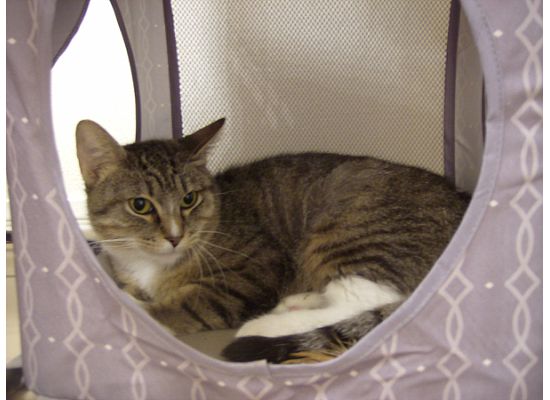This is the story of what started out as a euthanasia. A Good Samaritan brought in a cat she found dragging both rear legs down her street. “Dr. Revel, you’ve got an ER in Room 2. Looks like an HBC.” That’s medical slang for “hit by car.” Oh no!
I walked in the room and introduced myself the client. I looked at my patient. A tiny little four pound gray tabby cat. One of the first things we vets do is to peel up the lip and look at the color of their gums…pale means blood loss, blue means can’t breathe, pink means good. I was a little shocked to see perfectly clean teeth. It was a baby, maybe a year old, but a very young cat. Her gums were a little pale, but not alarmingly so. She was so sweet. She looked at me with these knowing and innocent yellow eyes. Now just for perspective here, most HBC feral (wild) cats would be hissing at me and trying to claw my face off. Not this one. I put my stethoscope to her chest to listen to her heart and lungs. What on earth? She’s purring?! I looked at her spine and back legs. She had no sensation. Zero. They were both paralyzed. Ugh. There’s a reflex called “deep pain.” It’s where we pinch in-between the toes really hard and they draw their leg away. Well, they are supposed to. She didn’t. No deep pain. That’s bad. That means permanent paralysis. At least she couldn’t feel any pain.
I talked it over with the good Sam. She requested that we humanely euthanize this poor paralyzed kitty. It was a reasonable request. I took the cat to the treatment room to put an IV catheter in her that would deliver the drug that would allow her to peacefully pass away. I pet her as the nursed placed her catheter. Wait! The muscles in her back legs were atrophied. That’s a vet word for wasted away. Atrophied! That doesn’t happen over night. She’s been this way for…well…probably a month. She survived outside, stray, for a month with paralyzed back legs! This was not a cat I could euthanize. This was a cat who wanted to live!!!
I went back into the exam room to talk to the Good Sam. I tearfully asked her if she would sign the cat over to me so I could find her a home. She kindly agreed and very generously donated money towards the cat’s care. I will forever be grateful to this woman.
I took some X-rays of the cats pelvis and abdomen (belly) and saw that her hip bones had been completely crushed. Three of her backbones were luxated (out of place) but no broken spine. On the X-ray I could see digested bone meal in her colon. By some miracle, this cat had hunted on two legs. Though severely emaciated, she was able to eat just enough to stay alive. I treated her fleas and ear mites and put her in one of the hospital cages with some cat food. Man, did she chow down! I finished out the rest of my day at work, and did some online research into “cat carts”….wheel chairs for cats. I said goodnight to my gimpy new friend and headed home.
The next morning it was back to work to start my 10 hour shift. Hmmm….the cat didn’t look so good today. A little lethargic. Not purring today. And I wasn’t hearing good breath sounds on the right side of her chest. We put the ultrasound (sonogram) probe on her belly and saw a fluid filled uterus. This is very bad. 99% of the time, fluid in the uterus means a uterine infection called a pyometra. We’re taught in vet school, “never let the sun set on a pyo.” That means, go to surgery immediately, do not pass go, or this cat will die.
We took full body X-rays. Oh no! There is was in all it’s glory. Her diaphragm was torn. The muscle that separates your belly from your chest was ripped. Her guts and liver were in her chest right next to her heart and lungs! Two of her lung lobes were collapsed and there was fluid surrounding the rest of her lungs making it harder for her to breathe. The big meal I fed her the night before caused her intestines (which were in her chest) to get full which made her feel all the worse. Her partial starvation was keeping her alive. Lower in the X-ray you could see her fluid filled uterus, and still lower, her crushed pelvis. My coworker took one look at this train wreck. “This cat is toast,” he said.
There were two choices at this point. Humanely euthanize or go to emergency surgery. I never considered the first option. Without much thought, I moved forward with option two. Going in on an emergency pyometra spay, diaphragmatic hernia repair. Once I opened her abdomen, her entire chest cavity would be exposed from the hernia. You know on those medical dramas on TV when they call in the talented thoracic surgeon? Well, that was going to have to be me. A general practitioner, who hasn’t seen an open chest surgery since vet school, and, until this point, has certainly never performed one. I’m not really sure what came over me, but I never stopped to hesitate. I knew what I had to do and I was ready to do it.
We anesthetized the cat and prepped her for surgery. I took a deep breath and began. I slid my scalpel blade down the middle of her belly. She was so thin, her skin was like paper. Her tissues were paler than my usual healthy spays. She was anemic from months of fleas sucking her blood. I found her uterus. Not what I was expecting. Remember when I said fluid in the uterus was an infection 99% of the time? Well, this was the 1% that wasn’t. It was a cyst. Weird. But I didn’t have time for that. I spayed her as quickly as I could, all the while knowing her open chest was just to my right. I didn’t look there yet. I stayed focused.
Spay complete. Now for the hernia. I extended my incision toward her diaphragm. Oh boy. There it was. Her open thorax. I saw the gaping hole in her muscle. I gently guided out several feet of small intestine and replaced them to their abdominal home. Next. An entire liver lobe was stuck in the chest. A four inch wide organ that I needed to deliver out of a three inch hole. Kinda like delivering a really big baby. Except this baby is the body’s detoxifying organ, so if I squeeze it, I could flood the bloodstream with toxins and kill the cat. And if I knick it, she could bleed to death. And if I widen the hernia to make it easier, I could knick her lung or heart. No pressure. Deep breath. Gentle hands. I delivered it through.
Now that I had removed her belly organs from her chest, I was left with a hole and a view to a live open chest. I saw her tiny heart beating. I saw her pale pink lungs inflate with each movement of the ventilator she was on. Well, most of them. Two of the lung lobes on the right were collapsed, useless flaps of flesh that every specialist would agree would stay permanently so. I grabbed some non-dissolving suture. I stitched the hole closed. That closure needed to last her a lifetime. I took more suture and sewed it again. I once saw a TV show where they said anyone worth shooting once is worth shooting twice. Well, I figured this hole was worth fixing twice.
With the last stitch, I placed a tube in the chest cavity and sucked out all the air around the lung space. I closed her up. All the kings horses and all the kings men….well, they should have gone to vet school.
I took the cat home with me to foster her. Her wounds healed. Her hair grew in. She gained nearly 3 pounds! I knew all of that would happen. But what I never expected and would have guaranteed would never occur, is what happened next.
I took the cat to several veterinary specialists: a surgeon, a neurologist, a physical therapist, an acupuncturist. All were in agreement. There was no surgery to fix her shattered pelvis and the nerves in her back right leg were dead. She had a small amount of nerve function in her left rear leg. So the plan was, try to strengthen her left rear so we can amputate the right rear. Cats can do really well on three legs. Otherwise, she would need a wheel cart. I started physical therapy daily (which she purred through, every time) and acupuncture once a week.
Within a week, she was moving both back legs! She was still dragging them and knuckled over, but they were moving!! Both of them. By week three, she was no longer knuckle walking, but actually walking on her paw pads. Like a normal cat. With no nerve sensation. She could step over an obstacle, go up and down the stairs, and even jump onto the counters and window sills.
How on earth this cat is able to walk will remain a mystery to every veterinary professional involved in her care. As I write this she is doing her favorite thing….sitting on my lap purring. I’m not sure how many of her nine lives she sacrificed surviving a shattered pelvis, 3 luxated back bones, 2 collapsed lungs, flea bite anemia, partial starvation, a diaphragmatic hernia, pleural effusion (fluid in her chest), and most significantly, a vet who had already drawn up the euthanasia solution to put her to sleep.
Like most vets, I am a sucker, and this amazing cat who taught me so much about not giving up ended up finding a pretty good home….mine.
Sometimes, when I am watching her, I think back to that horrific X-ray I put up and the general consensus of every reasonable person that said “this cat is toast.” I’m glad I wasn’t reasonable on that day. But I did name her….Toast.


